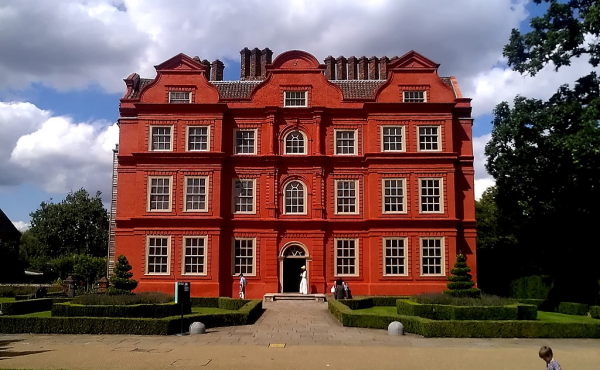 |
| The Dutch House at Kew Palace, where the Duke and Duchess of Kent and the Duke and Duchess of Gloucester had a double wedding ceremony in June 1818 (Wikimedia Commons) |
Thursday was the day appointed for the marriage of His Royal Highness the Duke of Clarence [1] with Her Serene Highness the Princess Adelaide of Saxe-Meiningen [2] and the remarriage of the Duke [3] and Duchess of Kent [4], for which purpose various preparations were made.
At an early hour a carriage arrived at Kew Palace [5] with the massy, ancient, and valuable plate belonging to the Chapel Royal, St. James’s Palace [6], and Whitehall Chapel [7]. Some of it is as old as the time of King William [8], and among which is a solid gold cup of the King’s. On the arrival of the plate there, the persons entrusted with the care of it were informed that the marriage of the royal dukes was postponed till Saturday; it was, however, arranged that the plate should remain at Kew Palace till the marriages were solemnized.
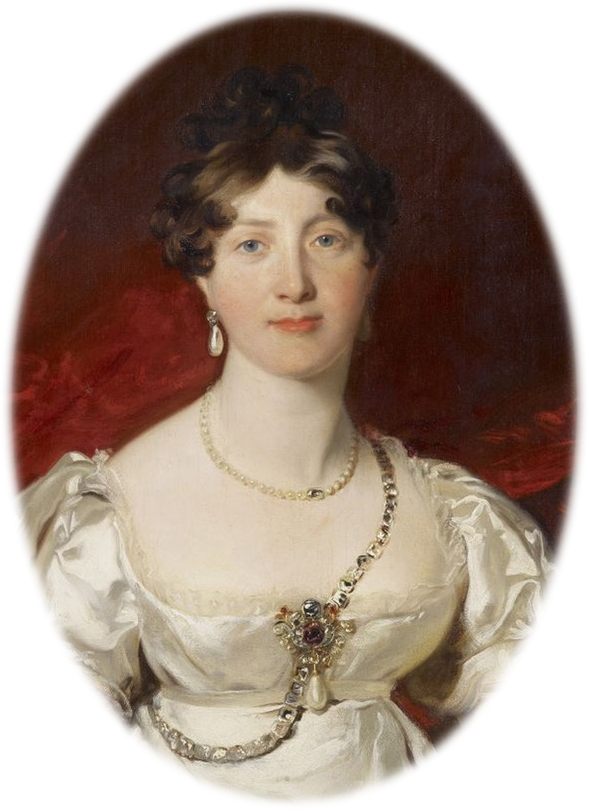 |
| A contemporary portrait of Princess Mary, Duchess of Gloucester and Edinburgh, sister of the grooms, painted by Sir Thomas Lawrence (Grand Ladies Site) |
The postponement of the time of the marriages was settled on Wednesday evening, when the Prince Regent [9] dined with the Duchess of Gloucester [10] and the Princess Augusta [11] at Kew Palace. The cause of the postponement is not generally known, but it is understood that it was the wish of the Queen [12] to be present at the solemnization, as well as the particular desire of the royal dukes; and as Her Majesty’s health was in a progressive state of improvement, since her severe attack on Sunday night, it was hoped that her health and strength would be improved by the delay of a few days. Her Majesty was much better on Saturday, the day finally fixed upon, and all those persons were invited whose official situation demanded their attendance at the solemnization of the marriages.
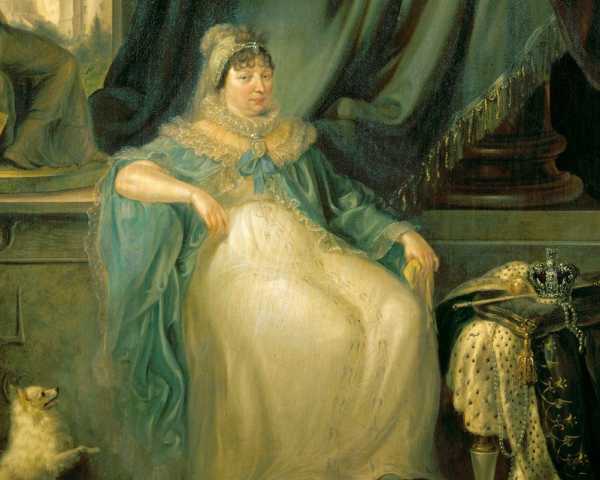 |
| A detail of an 1807 portrait of an elderly Queen Charlotte of the United Kingdom, painted by Peter Edward Stroehling more than ten years before this double royal wedding (Wikimedia Commons) |
At an early hour on Saturday morning, Mr. Banting, of the House of France and Banting, the royal upholsterers, arrived at Kew Palace and fitted up a temporary altar in Queen’s drawing room, which looks into Kew Gardens, on the first floor. The rail of the altar was extended for the accommodation of the four royal personages, with four crimson velvet cushions for them to kneel on, and the whole was covered with crimson velvet. The valuable and magnificent communion plate, belonging to the Chapel Royal and Whitehall Chapel, which had a most elegant and splendid appearance, was displayed on this occasion.
The royal pairs, the other branches of the royal family, and others necessary to be present, had all arived before four, at which hour the Queen was conducted into the drawing room, and took her seat on the right side of the altar, in the same situation as at the marriage of the Princess Elizabeth with His Serene Highness the Prince of Hesse-Homburg [13], the altar being fitted up exactly in the same style, only extended wider, to admit of four personages.
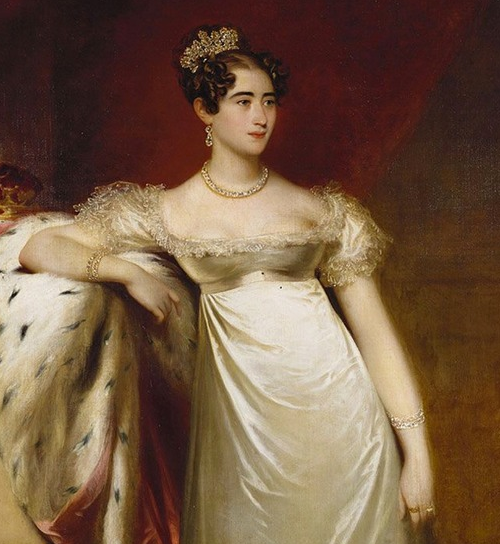 |
| Detail from a portrait of Princess Augusta, Duchess of Cambridge, sister-in-law of the grooms, painted in 1818 by William Beechey (Grand Ladies Site) |
The Prince Regent attended the Queen on her entrance into the drawing room, and was followed by the Duke and Duchess of York [14], the Duke and Duchess of Cambridge [15], the Duchess of Gloucester, the Princess Augusta, the Princess Sophia of Gloucester [16], the Landgrave of Hesse-Kassel [17], the Duchess of Meiningen [18], the Lord Chancellor [19], the Earl of Liverpool [20], Viscount Sidmouth [21], and Count and Countess Munster [22].
The Duke of Clarence and his intended bride, and the Duke and Duchess of Kent, being introduced into the room in due form, and having taken their station at the altar, the Archbishop of Canterbury [23] commenced the marriage ceremony in which he was assisted by the Bishop of London [24]. The brides had the honour of being given away by the Prince Regent. The Lord Chancellor produced the sanction of the Regent in Council to the marriages.
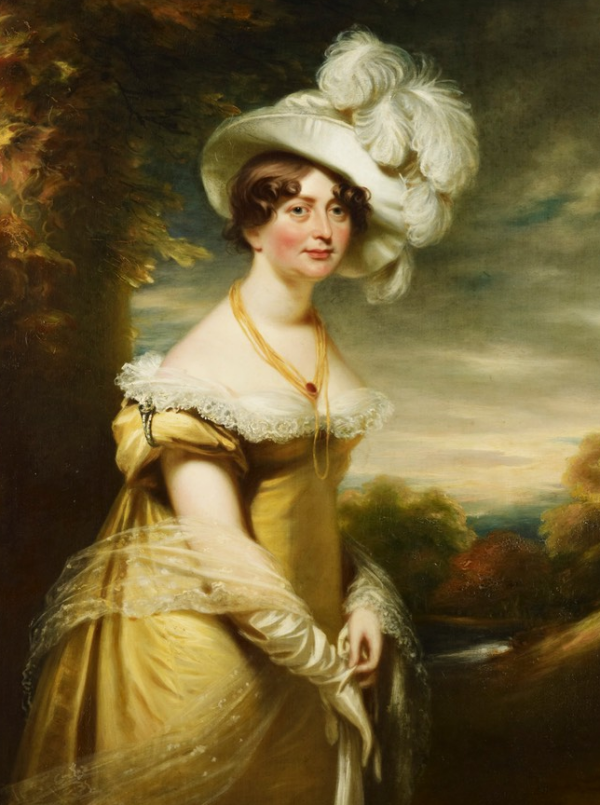 |
| A portrait of Princess Augusta of the United Kingdom, sister of the grooms, painted ca. 1819 by William Beechey (Wikimedia Commons) |
After the ceremony, Mr. Howse, the Sergeant of the Vestries of the King’s Chapels Royal, was in attendance with his gold verge of office, and produced the registry book of the Chapel Royal, St. James’s Palace. The Bishop of London, as Dean of that chapel, registered the marriages in the book accordingly, which was witnessed by the Queen, the Prince Regent, and all the branches of the royal family present, according to their rank, after the new married pairs had signed the registration. The Lord Chancellor, the Earl of Liverpool, as Prime Minister, and Viscount Sidmouth, as Secretary of State for the Home Department, signed the register book, as three of the Privy Councillors who were present when the sanction in council was given to the marriages.
The ceremony of official proceedings occupied three quarters of an hour. Although the ceremony for both marriages was performed at the same time, the signing of the registration was doubly entered. At the conclusion of the whole, the Archbishop of Canterbury, the Bishop of London, the Lord Chancellor, and Viscount Sidmouth left Kew.
The Queen retired to her private apartment, where dinner was served up, the state of Her Majesty’s health not permitting her to dine with company, and after she had partaken of it she found herself in a very composed and comfortable state. At five o’clock the Prince Regent and the remainder of the company sat down to a most sumptuous dinner, which was served up on silver plate, part of which was brought from the Queen’s Palace [25] for the occasion.
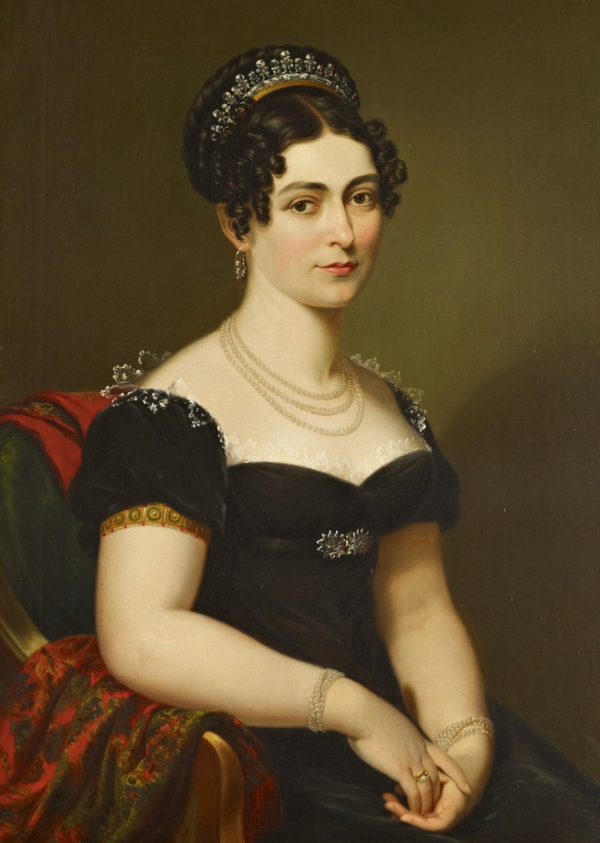 |
| Princess Victoria, Duchess of Kent, one of the brides, painted in the summer of 1818 by George Dawe (Grand Ladies Site) |
Soon after half-past seven o’clock the Duke and Duchess of Kent left in Prince Leopold’s [26] travelling chariot, drawn by four beautiful greys, for Claremont [27]. The Earl of Liverpool left in his carriage and four about the same time. The Prince Regent and all the royal party proceeded in open carriages to the cottage in Kew Gardens, near the pagoda (which was a great favorite of the King’s [28]), where they drank tea; after which the Duke and Duchess of Clarence left in a new travelling chariot, launched for the occasion, with their joint arms.
Their Royal Highnesses proceeded from Kew to the royal duke’s residence in St. James’s Palace [29]; which, being brilliantly illuminated to receive the new married pair, particularly the light which blazed from the elegant lustre in the drawing room, attracted a number of people in front of the house to see the Duchess, who continued patiently to wait, although it rained fast, from between eight and nine o’clock.
At the conclusion of the ceremony, General Taylor [30] dispatched a light horseman to London, announcing that the marriages had taken place, and at six o’clock a double royal salute was fired by the guns in the park, and the bells of several parishes were set a-ringing.
The Duchess of Kent’s wedding dress: a very rich and elegant gold tissue, with two superb borders of scolloped lama flouncing, each border headed with rich gold trimming. The body and sleeves to correspond, richly trimmed with beautiful Brussels point lace, and tastefully ornamented with gold tassels. The robe of rich gold tissue, lined with white satin, and trimmed round with rich scolloped lama trimming to match the dress, and fastened at the waist with a very brilliant diamond clasp. Head dress a wreath of diamonds.
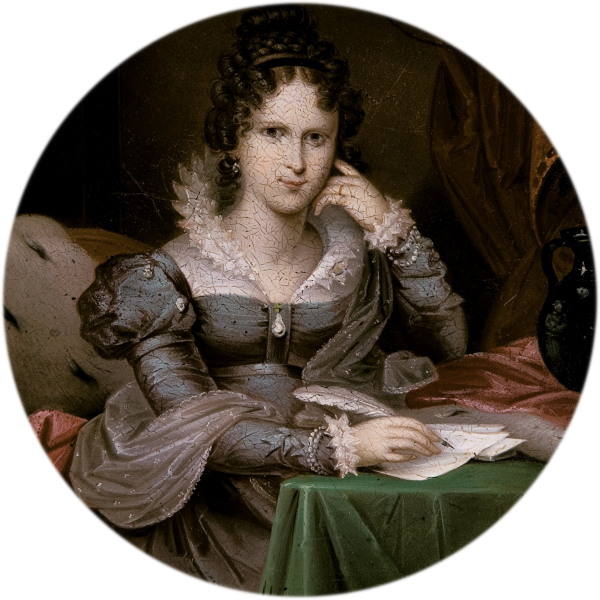 |
| A miniature of Princess Adelaide, Duchess of Cambridge, one of the brides, painted in 1818 by Samuel Raven; unfortunately much of the paint on the miniature has since cracked (Wikimedia Commons) |
The Duchess of Clarence’s wedding dress: a very rich elegant silver tissue, with two broad flounces of beautiful Brussels point lace, each flounce headed with rich silver shell trimming. Body and sleeves superbly trimmed with Brussels point lace and silver tassels. The robe of rich silver tissue, lined with white satin, trimmed with Brussels lace, and bordered with silver trimming to correspond, fastened at the waist with a brilliant diamond clasp. Head dress, a superb wreath of diamonds.
NOTES
1. Prince William, Duke of Clarence (1765-1837), later King William IV of the United Kingdom, was the third child of King George III and Queen Charlotte. In June 1818, William was 52 years old. He’d never been married, but he’d lived with his actress companion, Dorothea Jordan, for two decades until her death in the summer of 1816; the couple had at least ten children, nine of whom were living in June 1818. After the death of his niece, Princess Charlotte of Wales, in November 1817, William and his brothers were encouraged to marry legitimately and produce heirs to secure the line of succession. In 1818, he secured a young German princess, Adelaide of Saxe-Meiningen, as his bride. They met for the first time on July 4, 1818, only days before their wedding.
2. Princess Adelaide of Saxe-Meiningen (1792-1849), later Queen Adelaide of the United Kingdom. Born in Meiningen in central Germany, she was the daughter of the Duke Georg I of Meiningen and Princess Luise Eleonore of Hohenlohe-Langenburg. She was 25 years old when she arrived in England in June 1818 to marry the Duke of Clarence, third son of King George III and Queen Charlotte of the United Kingdom. Although William was more than twice Adelaide’s age, they were apparently well-matched. They ascended to the throne as King William IV and Queen Adelaide in 1830, but because both of their daughters died in infancy, William’s niece, Victoria, succeeded them in 1837.
3. Prince Edward, Duke of Kent and Strathearn (1767-1820) was the fifth child of King George III and Queen Charlotte of the United Kingdom. When his niece, Princess Charlotte of Wales, died in November 1817 — leaving King George III with no legitimate grandchildren — Edward had been living with his companion, Julie de Saint-Laurent, for almost three decades. As Edward and his brothers looked for royal wives, Julie quietly left for Paris. Edward, who was 50 years old, didn’t have to look far for his future spouse: he became engaged to Princess Victoria of Saxe-Coburg-Saalfeld, who also happened to be the sister of Prince Leopold, the late Princess Charlotte’s husband. (Whew.) Edward and Victoria were married in a Lutheran ceremony on May 29, 1818 in Germany, and then again in June 1818 at Kew. Their most important legacy, without a doubt, was their only daughter, Queen Victoria.
4. Princess Victoria, Duchess of Kent and Strathearn (1786-1861), born Princess Victoria of Saxe-Coburg-Saalfeld. She was the seventh child of Duke Francis of Saxe-Coburg-Saalfeld and his second wife, Countess Augusta Reuss of Ebersdorf. In 1818, Victoria was the 31-year-old widow of the 2nd Prince of Leiningen, and she was serving as regent for their young son, Carl. She already had ties to the British royal family; her brother, Leopold, had married Princess Charlotte of Wales. When Charlotte died, and the Duke of Kent came looking for a bride, Victoria accepted, marrying him in a pair of ceremonies. They moved back to Germany with her children, but when she became pregnant with the future Queen Victoria, they hurried back to England so that she could give birth on British soil. Edward made her a widow once again when he died in 1820, and she focused much of the rest of her life on their daughter and her future role.
5. Kew Palace served as a royal residence between 1728 and 1818. This double royal wedding was held in the drawing room at the Dutch House, where Queen Charlotte died a few months later. The Dutch House survives today, located in Kew Gardens in London.
6. The Chapel Royal, St. James’s Palace has hosted many important royal religious services, including the weddings of Queen Victoria and Prince Albert and the future King George V and Queen Mary. In 1997, the body of the late Diana, Princess of Wales rested in the chapel before her funeral. More recently, the chapel has been the site of the confirmation of the Duchess of Cambridge and the baptism and confirmation of Meghan Markle, as well as the baptism of Prince George of Cambridge.
7. After fire destroyed the majority of the Palace of Whitehall in 1698, the Banqueting House was converted for use as a chapel. It served that purpose until 1893, when Queen Victoria donated it to the Royal United Services Institution.
8. This is likely a reference to King William III (1650-1702), who reigned jointly with his wife, Queen Mary II (1662-1694).
9. The Prince Regent (1762-1830), later King George IV of the United Kingdom. In June 1818, George was 55 years old. He had served as regent for his father, the incapacitated King George III, for seven years. In November 1817, his only child, Princess Charlotte of Wales, had died shortly after the birth of her son, who also died. George had been estranged from his wife, Princess Caroline, for two decades, and by the summer of 1818, she was 50 years old. There would be no more heirs for George. He became king in 1820, but he was succeeded a decade later by his brother, King William IV.
10. Princess Mary, Duchess of Gloucester and Edinburgh (1776-1857) was the eleventh child of King George III and Queen Charlotte. In the summer of 1818, she was 42 years old. Two years earlier, she had married her first cousin, Prince William Frederick, Duke of Gloucester and Edinburgh. She was particularly close to her eldest brother, the Prince Regent.
11. Princess Augusta of the United Kingdom (1768-1840) was the sixth child of King George III and Queen Charlotte. She was 49 years old in June 1818. Although she never publicly married, some biographers believe that Augusta may have been “privately” married to her longtime lover, General Sir Brent Spencer, an army officer who also served as a member of parliament.
12. Queen Charlotte of the United Kingdom (1744-1818), born Duchess Charlotte of Mecklenburg-Strelitz, was Britain’s queen consort through her marriage to King George III of the United Kingdom. In June 1818, Charlotte was seriously unwell, probably suffering from what we’d recognize today as congestive heart failure. Only a few months after these weddings, in November 1818, Charlotte died at the Dutch House in the Kew Palace complex.
13. Shortly before her 48th birthday, Princess Elizabeth of the United Kingdom (1770-1840), the seventh child of King George III and Queen Charlotte, married the Hereditary Prince of Hesse-Homburg on April 7, 1818 at the Queen’s House (now Buckingham Palace). The marriage allowed Elizabeth a measure of independence after a restrictive life in England. It also gave her new husband a significant financial boost.
14. Prince Frederick, Duke of York and Albany (1763-1827) was the second child of King George III and Queen Charlotte. In 1791, Frederick had married his cousin, Princess Frederica Charlotte of Prussia (1767-1820), but the match had been a disaster, and the Duke and Duchess had been separated since 1794. In the summer of 1818, Frederick was 54 years old, and Frederica was 51. They never reconciled, and they had no children.
15. Prince Adolphus, Duke of Cambridge (1774-1850) was the tenth child of King George III and Queen Charlotte. Like William and Edward, 44-year-old Adolphus had faced pressure to marry and produce a legitimate heir after the tragic death of his niece, Princess Charlotte of Wales, in 1817. He’d been sent to Germany to help find a suitable bride for William, and while he was there, he’d encountered 20-year-old Princess Augusta of Hesse-Kassel (1797-1889). Augusta’s father, Prince Frederick of Hesse-Kassel, had turned down William as a possible husband for his daughter. Instead, Adolphus himself proposed to Augusta. The match was approved, and Adolphus and Augusta married in two ceremonies: a German wedding in May 1818, and an ceremony at the Queen’s House (now Buckingham Palace) on June 1, 1818. The couple had three children, including the Duchess of Teck, mother of Queen Mary.
16. Princess Sophia of Gloucester (1773-1844) was a niece of King George III. Her parents were Prince William Henry, Duke of Gloucester and Edinburgh and Maria Walpole. Sophia was 45 years old in the summer of 1818; although she had once been suggested as a possible bride for her cousin, the Duke of Clarence, she never married.
17. William I, Landgrave of Hesse-Kassel (1743-1821) was a cousin of King George III through his mother, Princess Mary of Great Britain. He was also an uncle of Princess Augusta of Hesse-Kassel, who had recently married the Duke of Cambridge.
18. Princess Luise Eleonore, Duchess of Meiningen (1763-1837) was the mother of Princess Adelaide of Saxe-Meiningen, one of the brides at this double wedding. Following the death of her husband, Duke George I of Meiningen, in 1803, Luise served as regent for their young son, Bernhard. Just before this marriage, Luise used her regency powers in Meiningen to raise taxes to provide for Adelaide’s dowry.
19. John Scott (1751-1838) was in the middle of his second tenure as Lord Chancellor in June 1818. He had turned 67 a few days before this royal wedding. Three years later, King George IV raised him to the peerage, creating him Earl of Eldon.
20. Robert Jenkinson, 2nd Earl of Liverpool (1770-1828) was Prime Minister in 1818. In June 1818, Liverpool had just turned 48. He had been Prime Minister since the assassination of Spencer Perceval in 1812; he would continue in the role for nearly another decade, resigning after he suffered a stroke in 1827.
21. Henry Addington, 1st Viscount Sidmouth (1757-1844) was Home Secretary in 1818. The 60-year-old former Prime Minister continued in the role until 1822, when he was succeeded by Sir Robert Peel.
22. Count Ernst von Muenster (1766-1839) was a German aristocrat and diplomat who served as the Hanoverian Minister in London. His wife was born Wilhelmine von Lippe-Alverdissen (1783-1858).
23. Charles Manners-Sutton (1755-1828) served as Archbishop of Canterbury from 1805 until his death in 1828. Along with these royal weddings, he also presided over the coronation of King George IV in 1821 and the christening of the future Queen Victoria in 1819.
24. William Howley (1766-1848) served as Bishop of London from 1813 until 1828, when he succeeded Charles Manners-Sutton as Archbishop of Canterbury. He presided over the coronations of King William IV and Queen Adelaide (in 1831) and Queen Victoria (in 1838). He was also one of the two men who informed Queen Victoria that she had succeeded to the throne in 1837.
25. The Queen’s Palace, or Queen’s House, was a name often used for Buckingham Palace during George III’s reign, as the building had been purchased specifically for Queen Charlotte’s use.
26. Prince Leopold of Saxe-Coburg-Saalfeld (1790-1865), later King Leopold I of Belgium, was the widower of Princess Charlotte of Wales. He was also the brother of the Duchess of Kent, one of the brides at this royal wedding. A few weeks before this wedding, the Prince Regent (his father-in-law) had granted 27-year-old Leopold the style of Royal Highness. Leopold was offered the throne of Greece in 1830, but he turned it down; the following year, he accepted an offer to become King of the Belgians.
27. Claremont, a stately country house in Surrey, was given by the British people to Prince Leopold and Princess Charlotte as a wedding present in 1816. Leopold owned the home until his death in 1865. The home later belonged to the Duke of Albany, son of Queen Victoria and Prince Albert (and therefore Leopold’s great-nephew). Today the building is home to the Claremont Fan Court School.
28. King George III of the United Kingdom (1738-1820) was the father of both of the grooms at this double royal wedding. George, who had just turned 80, had been on the throne since 1760, but his deteriorating health led to the Regency Act of 1811. His eldest son, George, served as Prince Regent from February 5, 1811 until his father’s death in 1820. At the time of this wedding, George III was permanently confined in Windsor Castle.
29. William and Adelaide stayed at St. James’s Palace after their wedding, but they soon moved to Germany, where they lived for a year before returning to England. In 1825, William commissioned John Nash to build him a new home in London: Clarence House, which is now occupied by the Prince of Wales and the Duchess of Cornwall.
30. General Sir Herbert Taylor (1775-1839) was private secretary to three British kings: George III, George IV, and William IV. From 1811 until 1818, he was Queen Charlotte’s private secretary. It was also rumored that he had a romance with Princess Mary.
Leave a Reply